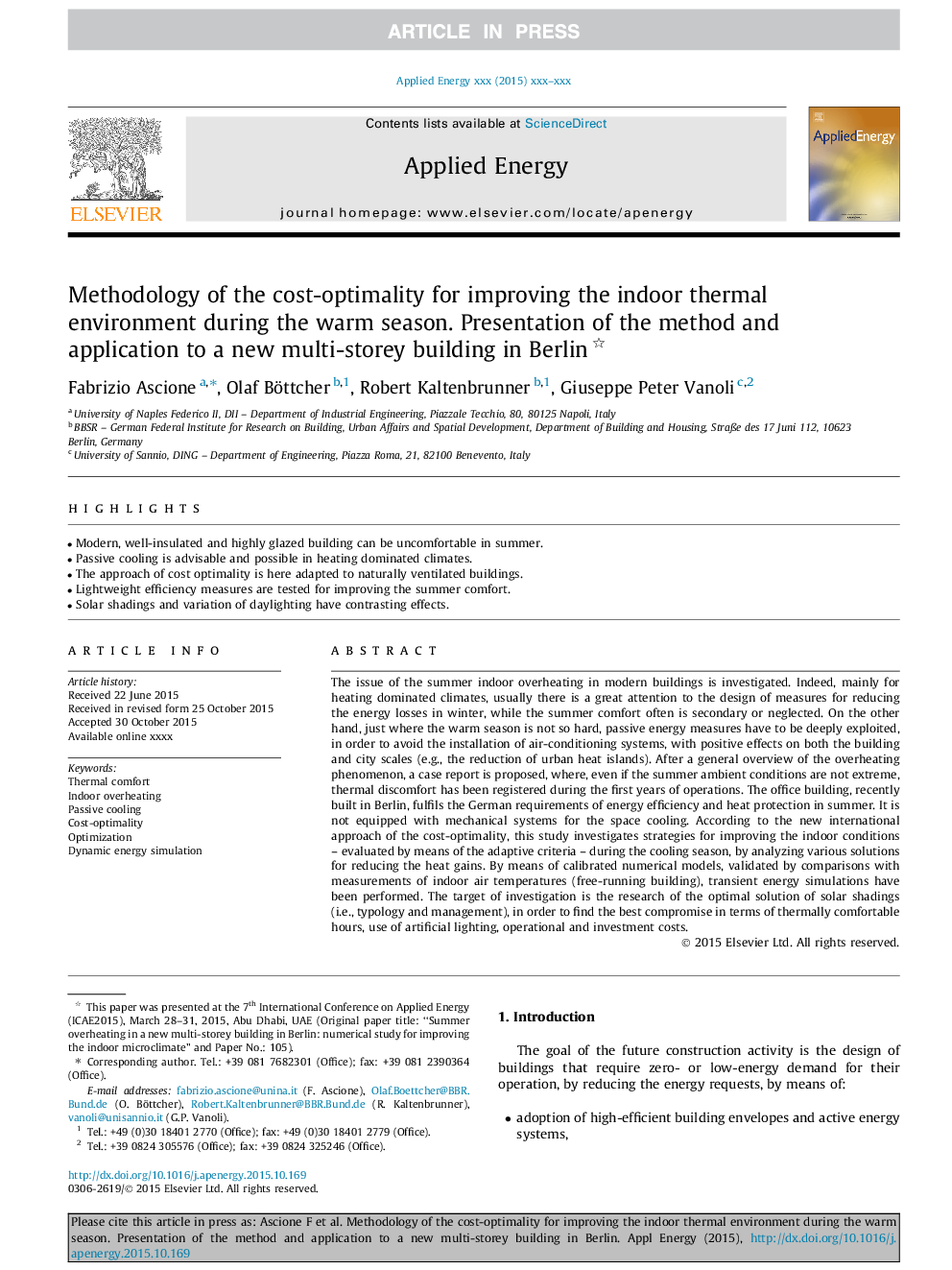| کد مقاله | کد نشریه | سال انتشار | مقاله انگلیسی | نسخه تمام متن |
|---|---|---|---|---|
| 4917086 | 1362739 | 2017 | 13 صفحه PDF | دانلود رایگان |
عنوان انگلیسی مقاله ISI
Methodology of the cost-optimality for improving the indoor thermal environment during the warm season. Presentation of the method and application to a new multi-storey building in Berlin
ترجمه فارسی عنوان
روش های بهینه سازی هزینه برای بهبود محیط حرارتی داخلی در فصل گرم. ارائه روش و کاربرد در یک ساختمان جدید چند طبقه در برلین
دانلود مقاله + سفارش ترجمه
دانلود مقاله ISI انگلیسی
رایگان برای ایرانیان
کلمات کلیدی
راحتی حرارتی، بیش از حد داخل سالن، خنک کننده منفعل، هزینه بهینه سازی، بهینه سازی، شبیه سازی انرژی پویا،
ترجمه چکیده
موضوع تابش سرپوشیده درونی ساختمان های مدرن مورد بررسی قرار گرفته است. در واقع، به طور عمده برای گرمازدگی در اکثریت اقلیم، معمولا توجه زیادی به طراحی اقدامات برای کاهش تلفات انرژی در زمستان وجود دارد، در حالی که آسایش تابستان اغلب ثانویه یا نادیده گرفته می شود. از سوی دیگر، صرفا جایی که فصل گرم خیلی سخت نیست، اقدامات انرژی منفعلانه باید عمیقا مورد سوء استفاده قرار گیرد تا از نصب سیستم های تهویه مطبوع اجتناب شود و اثرات مثبتی بر روی ساختمان ها و مقیاس های شهر (مثلا کاهش جزایر گرمایی شهری). پس از یک مرور کلی از پدیده گرمای بیش از حد، یک گزارش موردی پیشنهادی ارائه می شود که حتی در صورتی که شرایط شرایط تابستان به شدت نباشد، ناراحتی های گرما در طول سال های اول عملیات ثبت شده است. ساختمان اداری، اخیرا در برلین ساخته شده است، در تابستان، نیازهای آلمان برای بهره وری انرژی و حفاظت از حرارت را برآورده می کند. این سیستم مجهز به سیستم خنک کننده فضایی نیست. با توجه به رویکرد بین المللی جدید هزینه بهینه سازی، در این مطالعه استراتژی هایی برای بهبود شرایط محیطی - که با استفاده از معیارهای سازگاری - در طول فصل خنک کننده، با تحلیل راه حل های مختلف برای کاهش دستاوردهای گرما، مورد بررسی قرار می گیرد. با استفاده از مدل های عددی کالیبراسیون شده، با مقایسه با اندازه گیری دمای هوا در محیط داخلی (ساختمان آزاد در حال اجرا)، شبیه سازی انرژی گذرا انجام شده است. هدف از تحقیق، بررسی راه حل بهینه از سایه های خورشیدی (به عنوان مثال، نوع شناسی و مدیریت)، برای یافتن بهترین سازگاری از لحاظ ساعت های راحت گرما، استفاده از نور مصنوعی، هزینه های عملیاتی و سرمایه گذاری است.
موضوعات مرتبط
مهندسی و علوم پایه
مهندسی انرژی
مهندسی انرژی و فناوری های برق
چکیده انگلیسی
The issue of the summer indoor overheating in modern buildings is investigated. Indeed, mainly for heating dominated climates, usually there is a great attention to the design of measures for reducing the energy losses in winter, while the summer comfort often is secondary or neglected. On the other hand, just where the warm season is not so hard, passive energy measures have to be deeply exploited, in order to avoid the installation of air-conditioning systems, with positive effects on both the building and city scales (e.g., the reduction of urban heat islands). After a general overview of the overheating phenomenon, a case report is proposed, where, even if the summer ambient conditions are not extreme, thermal discomfort has been registered during the first years of operations. The office building, recently built in Berlin, fulfils the German requirements of energy efficiency and heat protection in summer. It is not equipped with mechanical systems for the space cooling. According to the new international approach of the cost-optimality, this study investigates strategies for improving the indoor conditions - evaluated by means of the adaptive criteria - during the cooling season, by analyzing various solutions for reducing the heat gains. By means of calibrated numerical models, validated by comparisons with measurements of indoor air temperatures (free-running building), transient energy simulations have been performed. The target of investigation is the research of the optimal solution of solar shadings (i.e., typology and management), in order to find the best compromise in terms of thermally comfortable hours, use of artificial lighting, operational and investment costs.
ناشر
Database: Elsevier - ScienceDirect (ساینس دایرکت)
Journal: Applied Energy - Volume 185, Part 2, 1 January 2017, Pages 1529-1541
Journal: Applied Energy - Volume 185, Part 2, 1 January 2017, Pages 1529-1541
نویسندگان
Fabrizio Ascione, Olaf Böttcher, Robert Kaltenbrunner, Giuseppe Peter Vanoli,
